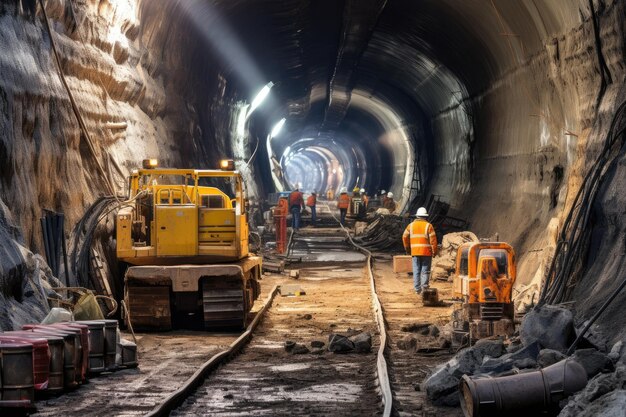In the field of tunnel construction and underground mining, ensuring safety and stability is critical. One of the most effective materials used to achieve this is shotcrete concrete. Shotcrete plays a vital role in reinforcing tunnels, stabilizing rock surfaces, and mitigating the risks of collapse. In this article, we’ll explore the importance of shotcrete concrete in tunneling projects and how it contributes to tunnel safety.
What is Shotcrete Concrete?
Shotcrete refers to concrete or mortar that is sprayed at high velocity onto a surface using specialized equipment. The material adheres to rock walls or other substrates, creating an instant, durable support layer. It is often used in underground applications, such as mining, tunnel construction, slope stabilization, and retaining walls.
Types of Shotcrete
- Dry-Mix Shotcrete:
- The dry materials are mixed at the nozzle, where water is added just before application.
- Advantages: Long transport distance possible and less wastage.
- Use Case: Ideal for remote sites with difficult access.
- Wet-Mix Shotcrete:
- The concrete is pre-mixed and pumped to the nozzle, where it is sprayed onto the surface.
- Advantages: Greater precision, less dust, and higher strength.
- Use Case: Preferred for large-scale projects requiring fast application.
Benefits of Shotcrete in Tunnel Construction
- Immediate Structural Support:
- Shotcrete provides early stabilization by adhering directly to the rock surface. This is crucial during the excavation phase of tunnels.
- Flexibility in Application:
- It can be applied to irregular surfaces and curved walls, making it ideal for tunnels, caverns, and mines.
- Reduced Downtime:
- The fast-setting nature of shotcrete ensures that tunneling operations can continue without long delays.
- High Strength and Durability:
- Once cured, shotcrete forms a solid and durable layer that enhances long-term stability.
- Cost-Effective:
- Shotcrete reduces the need for complex formwork, minimizing labor and material costs.
Role of Shotcrete in Tunnel Safety
Ensuring tunnel safety is essential to prevent accidents, collapses, or rockfalls. Shotcrete concrete plays a critical role in reinforcing underground structures and reducing hazards.
1. Rock Stabilization and Ground Control
- During tunnel excavation, the ground can shift or weaken, posing a significant danger to workers. Shotcrete layers act as a protective barrier, stabilizing loose rocks and preventing slippage.
2. Fire Protection
- Shotcrete provides fire-resistant properties, helping prevent damage in case of underground fires. In tunnels that carry vehicles or hazardous materials, this feature is especially important.
3. Water Seepage Control
- In areas prone to groundwater ingress, shotcrete acts as a sealing layer to control water seepage and maintain tunnel integrity.
4. Erosion Control
- Shotcrete resists erosion, ensuring the long-term durability of the tunnel lining and preventing deterioration caused by environmental factors.
5. Enhanced Safety for Workers
- Fast application means that dangerous rock surfaces are secured immediately, reducing the exposure of workers to unsafe conditions.
Application Process of Shotcrete in Tunnels
- Surface Preparation:
- The rock surface is cleaned of loose material and debris.
- Installation of Reinforcement:
- In some cases, steel mesh or rebar is added for additional strength.
- Shotcrete Application:
- Using a shotcrete machine, the material is sprayed evenly onto the surface.
- Curing:
- The shotcrete layer is allowed to cure, forming a solid, durable barrier.
Challenges and Solutions in Using Shotcrete for Tunnel Safety
| Challenge | Solution |
| Dust Generation | Use of wet-mix shotcrete to reduce dust. |
| Cracking During Curing | Proper curing techniques and moisture control. |
| Equipment and Accessibility | Compact shotcrete equipment for tight spaces. |
| Worker Safety During Spraying | Use of protective gear and ventilation systems. |
Key Equipment for Shotcrete Application in Tunneling
- Mincreter Machines:
- Compact machines ideal for applying shotcrete in narrow tunnels and mines.
- They allow for precise application, especially in confined spaces.
- Robotic Sprayers:
- Automated systems are used for large-scale tunneling projects, improving precision and worker safety.
Conclusion: Shotcrete and Tunnel Safety Go Hand in Hand
Shotcrete concrete is an indispensable material in modern tunneling and underground construction. Its ability to provide immediate stabilization, resist erosion, and control water ingress ensures the safety of tunnels and the people working inside them.
Whether for road tunnels, subway systems, or mining operations, shotcrete offers a fast, durable, and cost-effective solution for maintaining structural integrity. With innovations in equipment and materials, the future of tunnel safety continues to be driven by the reliable application of shotcrete concrete.


